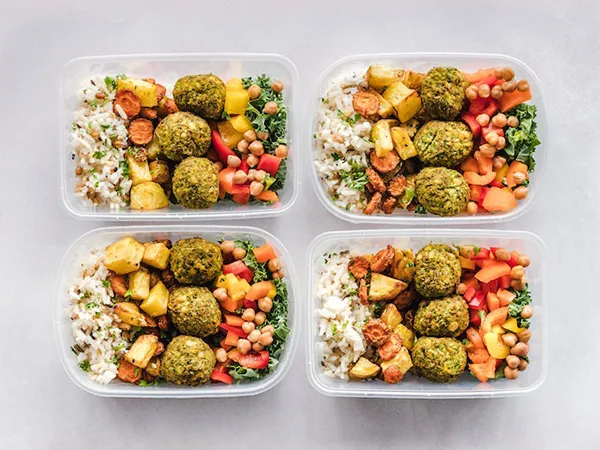How to cut a pepper: 7 Professional Cuts and Advice
Hey there veggie lovers! As a professional chef with over 10 years of experience, I’m pumped to share my secrets to mastering pepper cutting. Are you ready to become a pepper pro?! If you are looking for recipes to level up your skills in the kitchen, this guide is for you!

Today I’m talking about peppers, how to cut a pepper, what equipment you need, and sharing my favorite ways of doing it!
In this guide, you’ll learn pro tips to pick the perfect peppers, prep them like a boss, and slice and dice with skill. My step-by-step instructions will give you the confidence to chop peppers quickly and consistently. Get ready to level up your kitchen game! Let’s dive in!
Before you cut your pepper
Before we get into the specific cutting techniques, let’s quickly go over the basics. The two main types of peppers are sweet bell peppers and spicy chile peppers. For this guide, we’ll be focusing on bell peppers – those big, chunky, sweet ones that come in red, orange, yellow, purple, and even green peppers.
Bell peppers can transform meals with a crisp texture and bright, fresh flavor. But to get the most out of them in your cooking, it’s crucial to cut a pepper properly. Uniform slices will cook evenly, while precisely diced pepper pieces will infuse the taste consistently throughout a dish.
If your pepper-cutting skills are lacking, you end up with uneven chunks and slippery slivers. It’s not very appetizing, plus they get cooked at different rates. Proper slicing and dicing ensure your peppers are tidy for that professional flair.
The good news is that cutting bell peppers isn’t hard once you know a few basic techniques. With the right knife skills, a sharp knife, and a cutting board you will master those basics in no time. So let’s dive in – you’re about to seriously step up your pepper-chopping game!
How to cut a pepper: step by step
Before you start slicing and dicing peppers, it’s important to know how to choose fresh ones and get them prepped for cutting. Follow these tips:
Select bell peppers that are firm to the touch and peppers that feel heavy for their size at the store. Avoid ones with soft spots or wrinkles on the bell pepper skin.
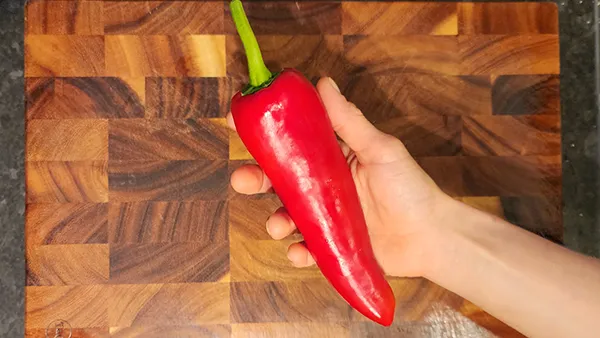
Remove them from the plastic bag (if you bought them in one). Wash them before prepping, even if labeled pre-washed.

Cutting Techniques
Alright, let’s get into the good stuff – step-by-step on how to cut bell peppers! Follow these methods for preparing uniform, professional-looking pepper pieces. Make sure you have sharp knives and a sturdy cutting board.
Sliced into Rings
This is the simplest way to cut bell peppers.
Slice the top off and take out the seeds with the help of a teaspoon. You can keep the stem end for stocks.
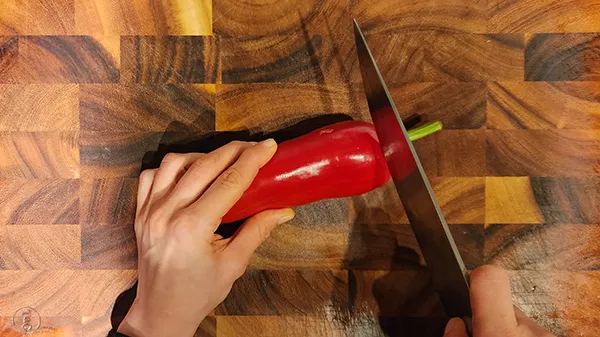
Slice across the width of the pepper to create rings.
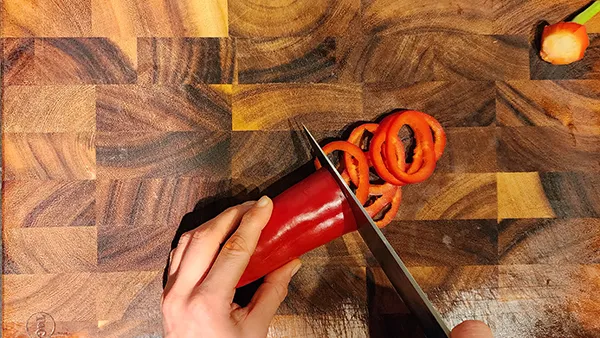
It does not get easier than this! Slicing peppers easily for adding crunch to your morning salads or sandwiches.
Prep your pepper
Before making some of the advanced cuts you will have to prep the pepper differently. Use a sharp knife.
Chop off the bottom, cutting about 3⁄4 inch (18-20 mm) from below, where it starts to curve.

Chop off the top of the pepper, cutting about 3/4, just below the stem.
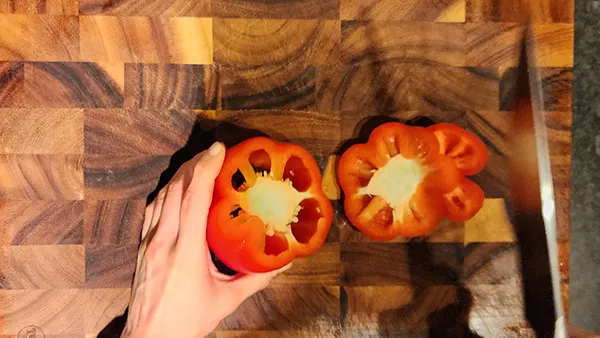
Stand the pepper upright. With the tip of your knife, make a vertical incision cut along the side of the pepper from top to bottom.
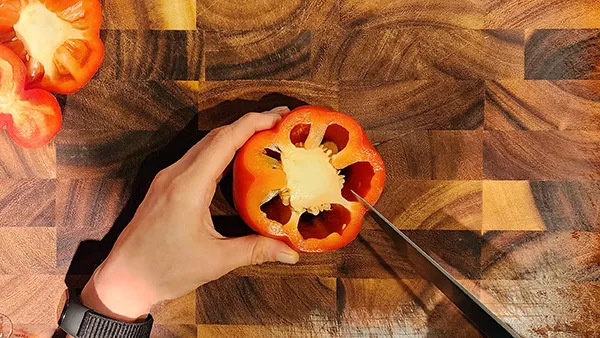
Gently open it up to expose the seeds and ribs inside. And slide in your chef’s knife.
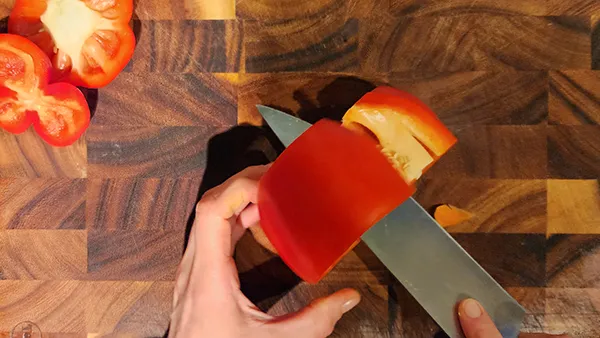
Carefully slice the pepper walls while rotating the pepper and cutting it into white ribs. Keep bell pepper flat and remove the core, pepper flesh, and seeds.
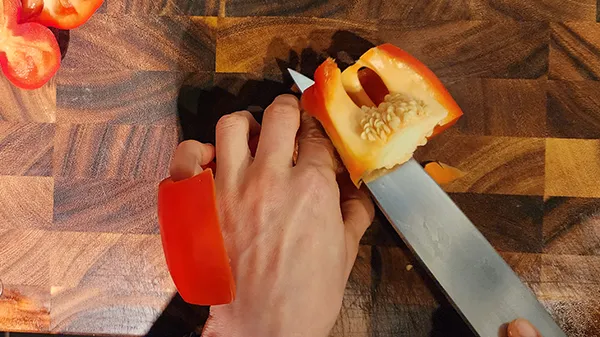
At this point, you have a clean pepper ready for any further cutting techniques such as dicing, julienning, etc.
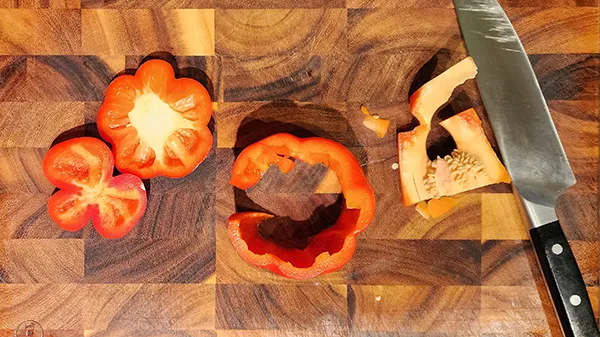
A paring knife works well for this task if you are not confident with a large chef’s knife just yet. You can keep the stem, seeds, and flesh. and use them later in tasty stock.
Strips or Batonnet
For long, slender strips, also called Batonnet in the kitchen world, place the pepper upright and cut the pepper in half lengthwise.
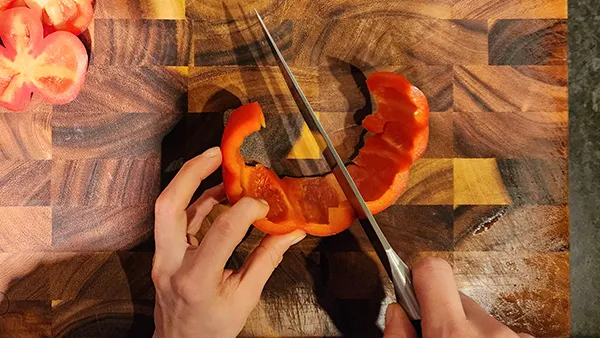
Place it flat with the pepper flesh facing up.
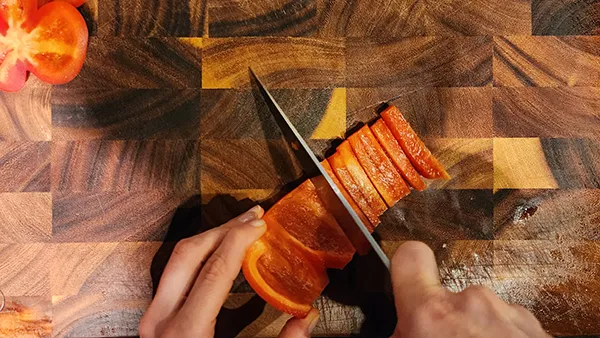
Then make lengthwise cuts to slice the pepper into thin strips.
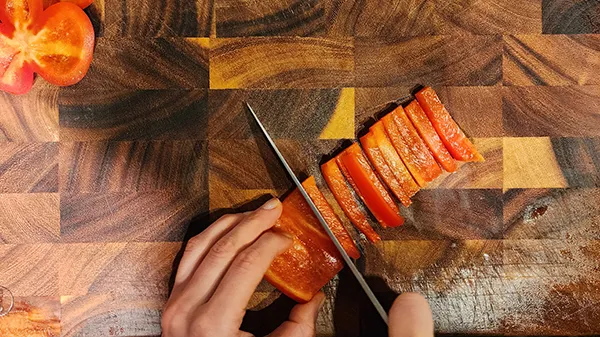
Batonnet measures approximately 1⁄4 by 1⁄4 by 2–2+1⁄2 inches (6 mm × 6 mm × 5 cm–6 cm).
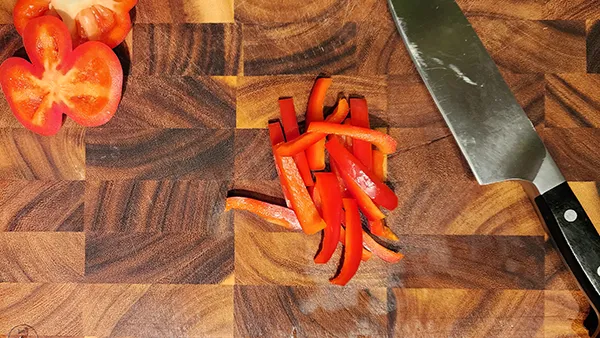
Add these spicy matchsticks to soups, stir-fry over-fries, and noodle dishes.
Fine Julienned
For long, fine strips, also called Julienne, place the pepper upright and cut the pepper in half lengthwise.
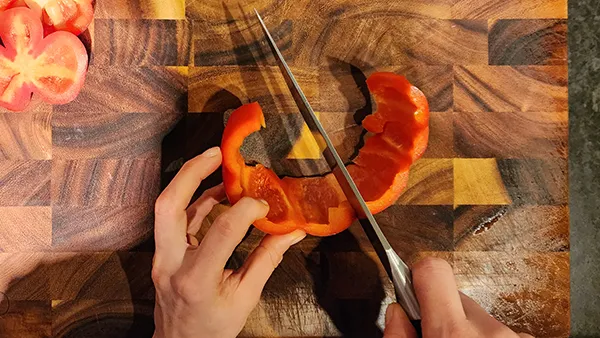
Then, cut the pepper lengthwise into quarters, dividing it into four equal rectangles.
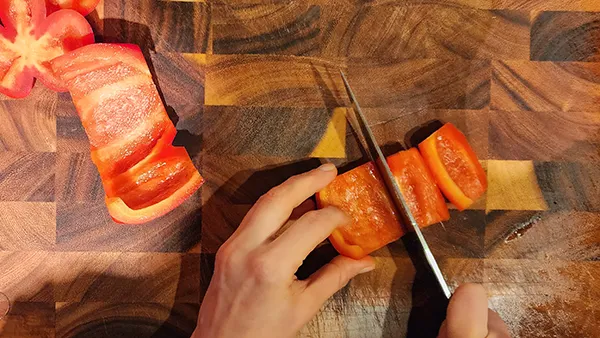
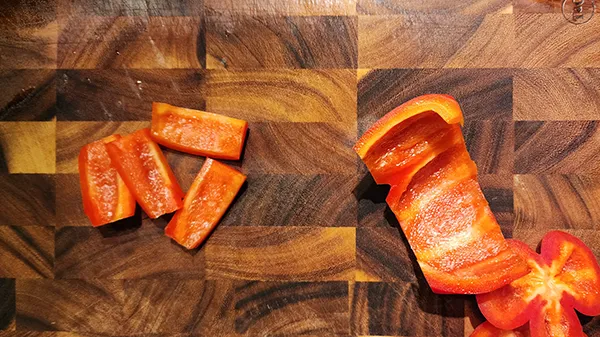
Next, slice each rectangle into half lengthwise, you will have 8 rectangles now.
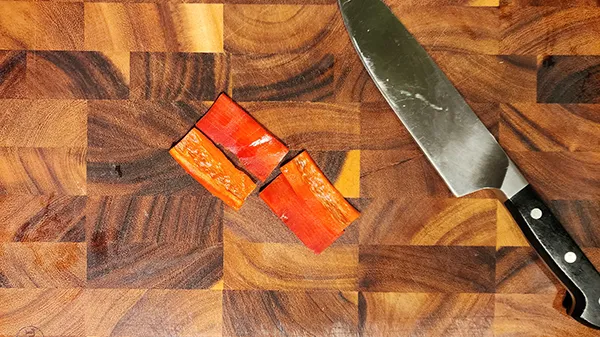
Stack a few of the rectangles on top of each other. Then, make very thin lengthwise slices to cut them into long, slender strips.
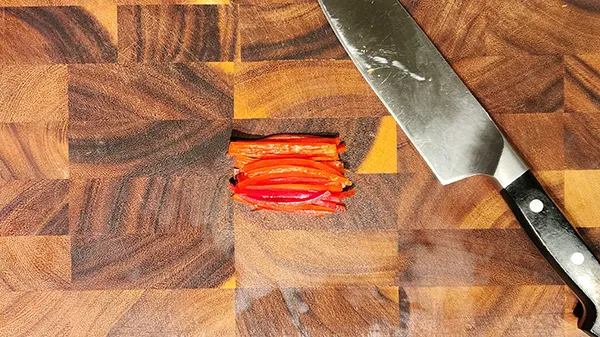
The julienne measures approximately 1⁄8 by 1⁄8 by 1–2 inches (0.3 cm × 0.3 cm × 3 cm–5 cm).
Julienned peppers can be used in a variety of dishes like stir-fries – The thin strips cook quickly and are easy to combine with other sliced veggies. They add crunch and flavor to the fillings of sandwiches or fajitas. And for salads thin slices will add a pop of color and a bit of spicy kick.
Cutting the pepper into fine julienne provides a great starting point for another cut called burnoise.
Dice
For big dice, place the pepper upright and cut the pepper in half lengthwise.
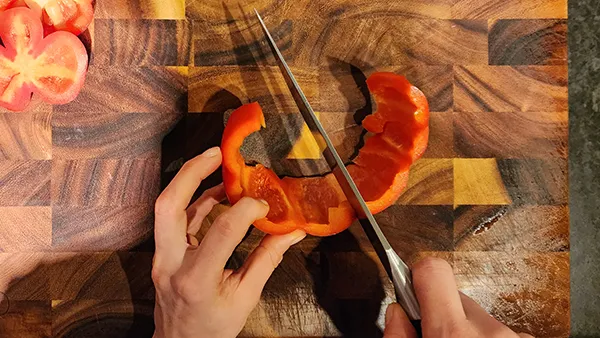
Next, lay the pepper halves cut-side down and slice them into 3⁄4 inch (18-20 mm) thick strips.

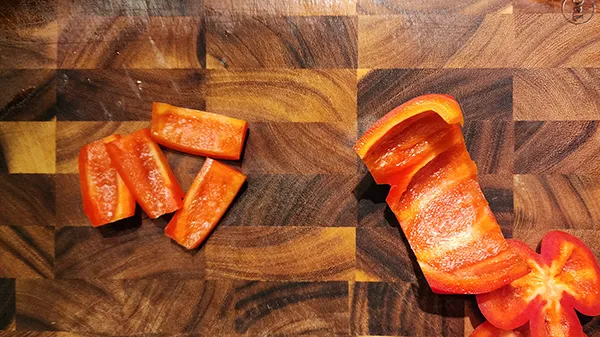
Then, stack a few strips on top of each other and cut across the strips to make 3⁄4 inch (18-20 mm) cubes.

Large dice is usually measuring approximately 3⁄4 inch (18-20 mm) on each side.
The large dice will add great texture and flavor to dishes like stews, chili, soups, and sautéed vegetables. Their hearty size stands up well to cooking.
Small Dice
For smaller dice, place the pepper upright and cut the pepper in half lengthwise.
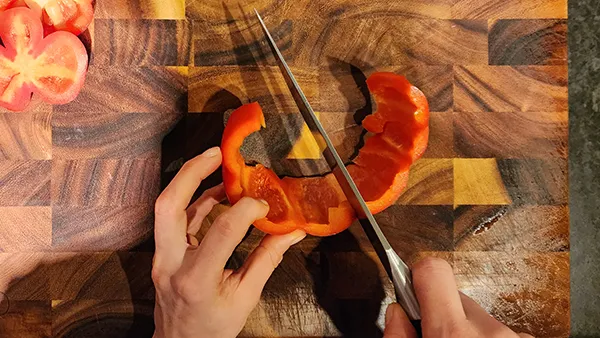
Lay the pepper halves skin-side down and slice lengthwise into 1⁄4 inch (5-6 mm) strips
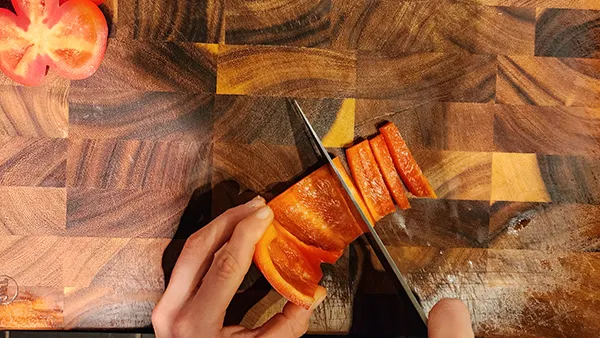
Line up the strips and cut perpendicular into 1⁄4 inch (5-6 mm) cubes.
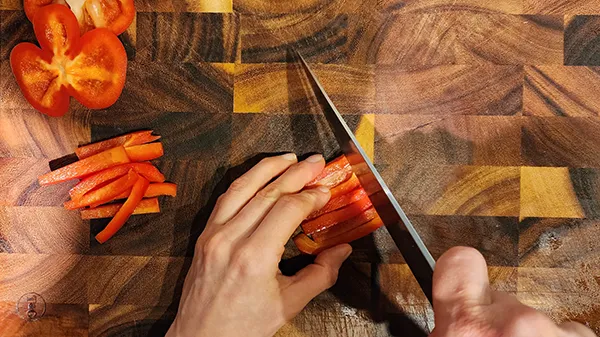
Chopping peppers into small cubes or dice adds tons of touch to sauces, salsas, and rice or grain dishes.
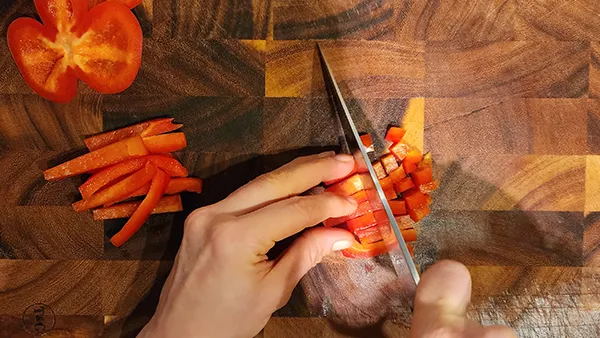
Small dice sides measuring approximately 1⁄4 inch (5-6 mm)
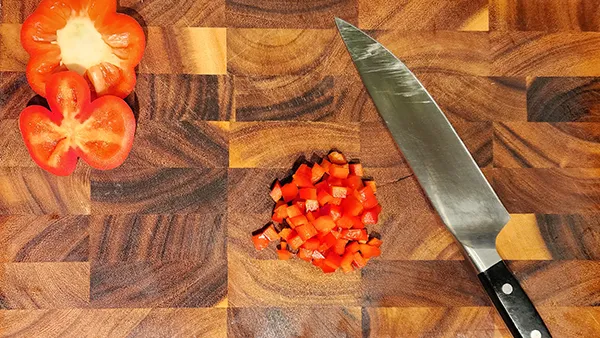
The tiny diced peppers are great for precision cooking and will deliver flavor in every bite. Perfect for dishes where you want the pepper well-incorporated like rice, quinoa, relishes, or anywhere a delicate dice is called for. I use these dice to add to my favorite chicken salad stuffed tomato.
Brunoise
For finely diced bell pepper, also called Brunoise, you will have to slice the pepper into julienne. Follow the steps above.
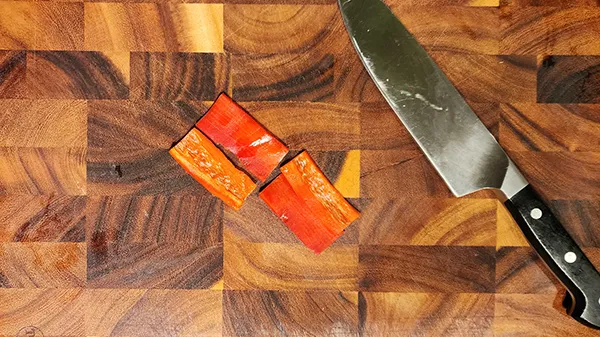
Slice lengthwise into 1⁄8 (3 mm) inch strips

Then cut across into 1⁄8 (3 mm) inch cubes.
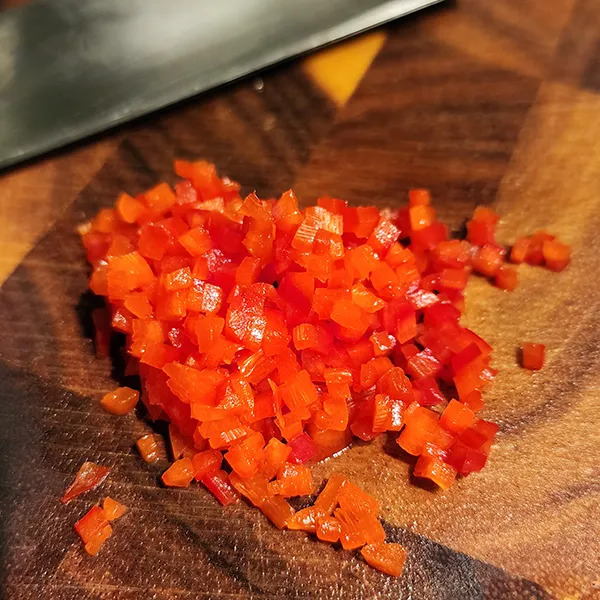
Brunose cut sides are measuring approximately 1⁄8 inch (3 mm)
Diced bell peppers are perfect for fine, uniform flavor in sauces or garnishes.
Prep for Stuffing
For stuffing, carefully cut around the stem with the tip of your knife.
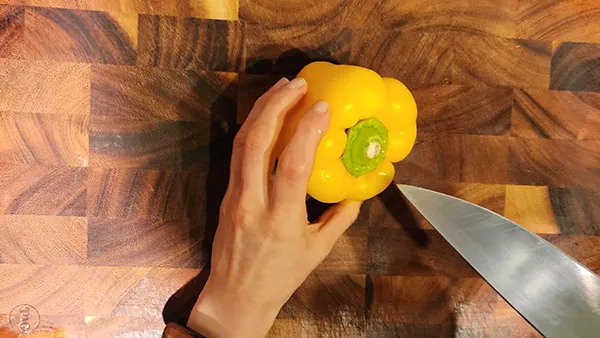
If you don’t feel confident with a large chef’s knife use a smaller paring knife.
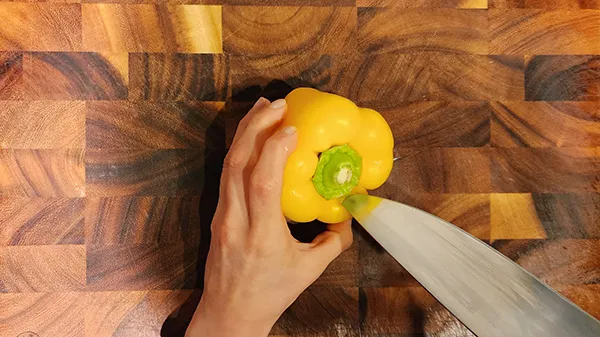
Be careful not to stab yourself, keep the blade away from your hands.
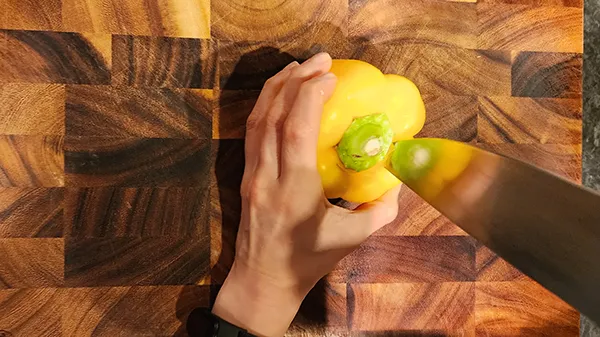
Slice the seeds off the stem for later use.

Scoop out the seeds and white ribs with the help of a spoon.
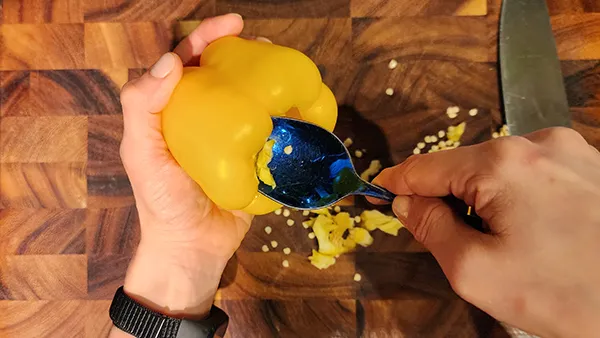
If you can’t get all of the white ribs out of it don’t worry too much about it, rinse it with water to get the last seeds out.
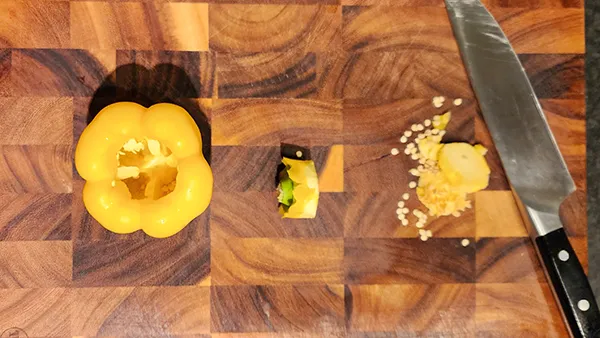
Keep the stem on for presentation
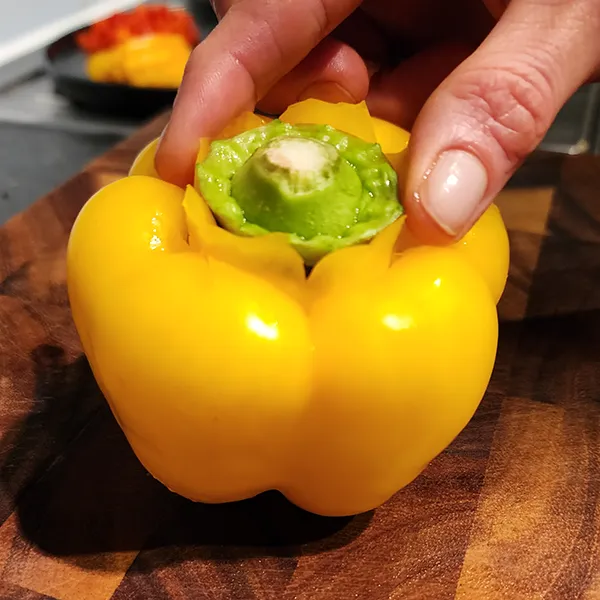
You can stuff your pepper with rice, quinoa, couscous, or any grain of your choice.
Stuffed peppers go well with a good source of protein, and garnish with fresh parsley or coriander.
Triangles
This is my favorite way to cut peppers for grilling. To cut bell peppers into triangles slice them in half from the top.
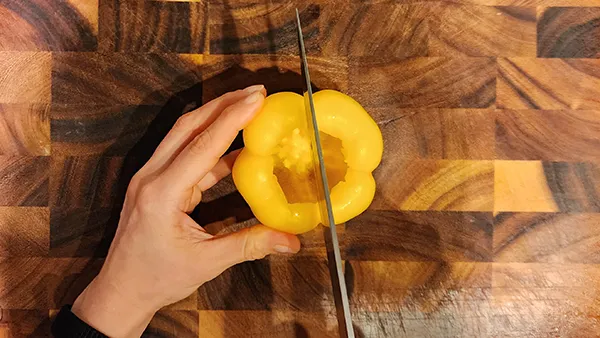
Then chop them into quarters.
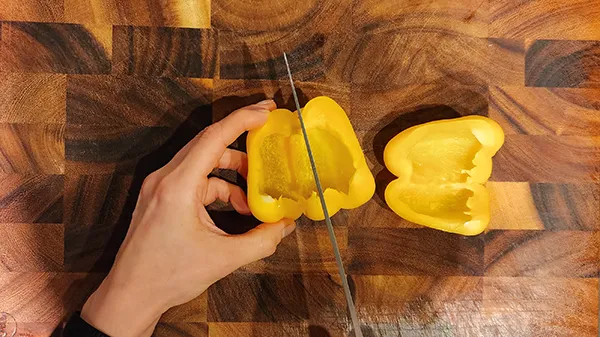
You should have 4 quarters.
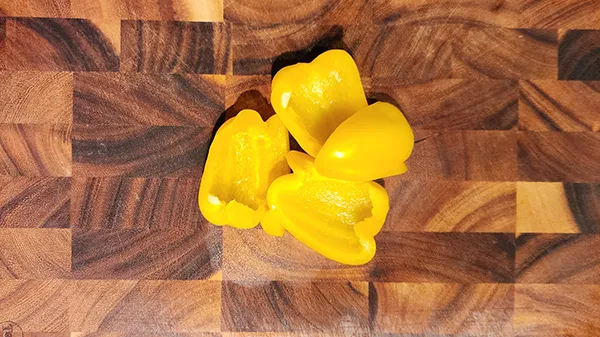
Then slice each quarter diagonally to make a triangle.
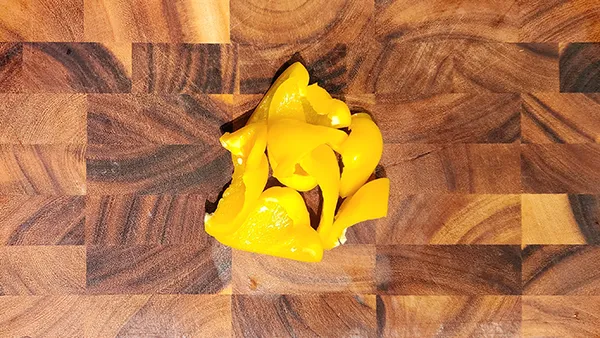
As I said this shape is perfect for grilling, but also works well for roasting, or just enjoying them as a fresh snack. Grill or roast these pepper wedges for charred flavor to add to tacos, flatbreads, pasta, and more.
Short strips
For a different look, a very sharp knife cut the pepper in half lengthwise.

Cut into strips around 1 inch (2-3cm) wide.
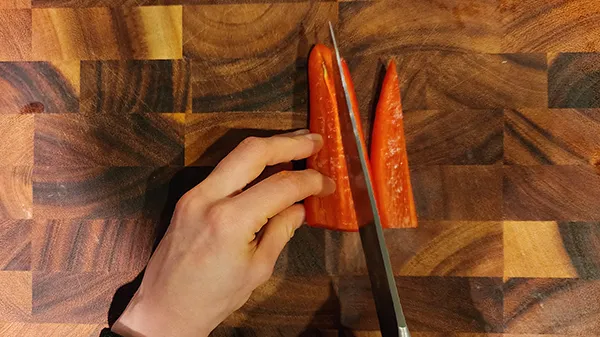
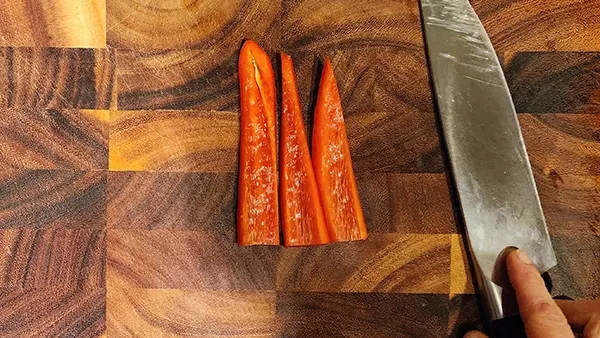
Turn them around and cut peppers into short strips.
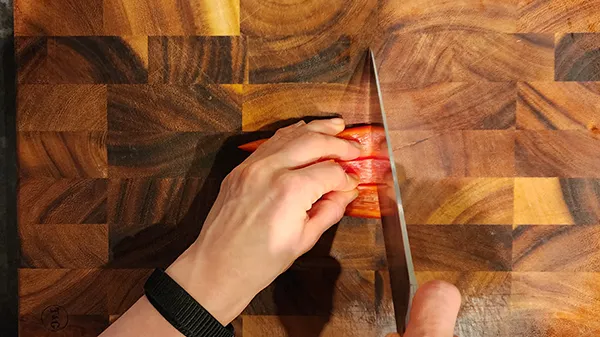
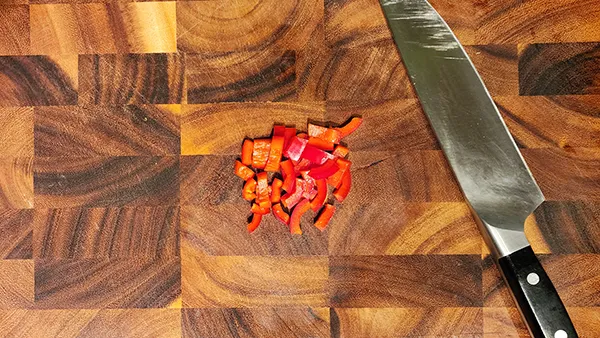
This shows off more of the peppers’ colorful skins and is nice in shorter pasta and salads. Also, this cut goes well with the veggie egg white omelet.
Peeling by Roasting or Torching
You can char and blister the skins by roasting or torching peppers before peeling. This develops a deeper taste for sauces and adds a smoky essence. Also used to pickle peppers.
Cooking and Eating Peppers
Now for the best part – actually eating peppers! Peppers have a variety of health benefits. Sure the cutting techniques are crucial, but prepping peppers perfectly lets you cook and eat them in so many amazing ways.
For cooked pepper, you can’t go wrong with methods like roasting, grilling, or sautéing to bring out the natural sweetness. Learn how to cut, select your favorite style, and toss them in the pan with a drizzle of olive oil and spices. Mmm, perfection!
And don’t forget about eating them raw too – peppers are awesome in fresh salads, dips, and crudité platters. Mix colors and slice shapes for a fun presentation. I love the crunch they add!
Conclusion
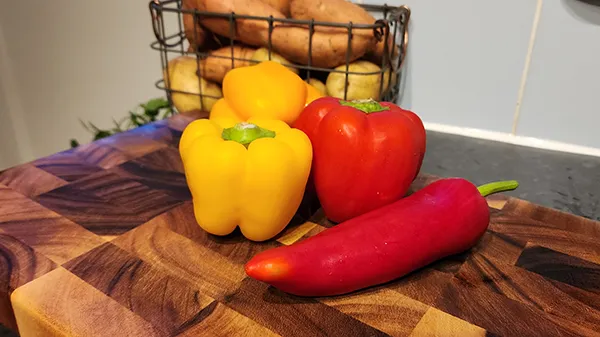
And there you have it, my pepper-chopping friends! Now you’re armed with all the skills to cut bell peppers like a total pro. In this post, I’ve shared my tips and personal preferences on how to cut and prep a bell pepper.
Follow my steps to prep peppers perfectly – from choosing firm ones to seeding and coring. From simple dicing to a complicated brunoise method.
With my tips, you’ll be prepping beautiful, tasty pepper pieces in no time!
And don’t forget to use storage tips: store diced peppers properly in an airtight container in the fridge and use them within 2-3 days for the best taste.
With these pepper-cutting tips, you’ll be prepping them like a professional chef in no time! Have a great week!
Remember, one bite at a time! Happy chopping!


